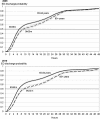Emergency department use by oldest-old patients from 2005 to 2010 in a Swiss university hospital
- PMID: 24011089
- PMCID: PMC3846121
- DOI: 10.1186/1472-6963-13-344
Emergency department use by oldest-old patients from 2005 to 2010 in a Swiss university hospital
Abstract
Background: Aging of the population in all western countries will challenge Emergency Departments (ED) as old patients visit these health services more frequently and present with special needs. The aim of this study is to describe the trend in ED visits by patients aged 85 years and over between 2005 and 2010, and to compare their service use to that of patients aged 65-84 years during this period and to investigate the evolution of these comparisons over time.
Methods: Data considered were all ED visits to the University of Lausanne Medical Center (CHUV), a tertiary Swiss teaching hospital, between 2005 and 2010 by patients aged 65 years and over (65+ years). ED visit characteristics were described according to age group and year. Incidence rates of ED visits and length of ED stay were calculated.
Results: Between 2005 and 2010, ED visits by patients aged 65 years and over increased by 26% overall, and by 46% among those aged 85 years and over (85+ years). Estimated ED visit incidence rate for persons aged 85+ years old was twice as high as for persons aged 65-84 years. Compared to patients aged 65-84 years, those aged 85+ years were more likely to be hospitalized and have a longer ED stay. This latter difference increased over time between 2005 and 2010.
Conclusions: Oldest-old patients are increasingly using ED services. These services need to adapt their care delivery processes to meet the needs of a rising number of these complex, multimorbid and vulnerable patients.
Figures



References
-
- NHAMCS. National Hospital Ambulatory Medical Care Survey: 2008 Emergency Department Summary. Hyattsville: Ambulatory and Hospital Care Statistics Branch National Center for Health Statistics; 2008.
-
- NHAMCS. National Ambulatory Medical Care Survey, 2005. Hyattsville: Ambulatory and Hospital Care Statistics Branch National Center for Health Statistics; 2005. (Volume 21560).
Publication types
MeSH terms
LinkOut - more resources
Full Text Sources
Other Literature Sources

